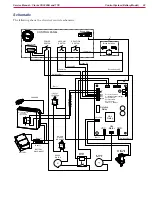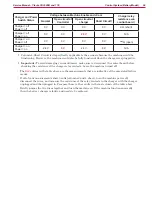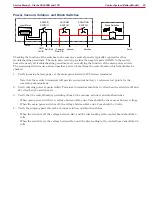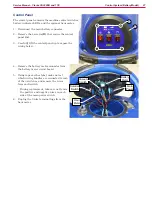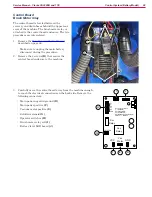
Control System (Corded Model)
14
Service Manual – Clarke CA30 20B and 17E
Solution Solenoid
The solution solenoid is a 120-volt magnetically controlled valve that permits fluid to gravity-flow to the
scrub deck. Power to the solenoid first passes through the main power switch, then the solution switch.
The neutral conductor passes straight to the solenoid, but the line-side conductor passes through the scrub
control relay before going to the solenoid. (See
Scrub Control Relay
described on page 15 for a description
of the scrub function.) This series connection causes the solution solenoid to be active only if the scrub
system is active. No solution will flow unless the brush is also active.
Brush Motor and Starter
The brush motor is a single-phase induction motor with a separate start winding to get the motor up to
operating speed. An analogy for this type of motor is the pedals on a bicycle, where the pedals are positioned
straight up-and-down, and can’t be started until the pedals are moved slightly past-center. The start
winding is used to “pull the pedals (motor winding) past center” so normal magnetism can cause complete
rotation.
The power through this start winding needs to be slightly delayed (electrically) from the main AC power,
which is accomplished with capacitors. When the motor is already running at-speed, the “Run Capacitor”
provides sufficient delayed-power to the start winding to keep the motor spinning past this “straight up-
and-down” position. However, when the motor is just getting started, it needs a little extra power (extra
kick) in the start winding to get moving. This is provided by an additional, larger capacitor, called a “Start
Capacitor”. During start-up, the Run capacitor and Start capacitor combine to give this extra amperage to
the start winding to begin to turn. However, this extra current
in the start winding would be too much current when running at
normal speed, so the Start capacitor must be disconnected from
the motor once it begins to turn near operating speed. This is the
function of the “Motor Start Relay”.
Motor Start Relay
The motor start relay controls when the start capacitor is
connected to the brush motor. The start capacitor needs to be
connected during startup, but to prevent too much current in
the winding, it must be disconnected once the motor is up to
speed. The start relay is a voltage-controlled relay that turns off
(normally closed contacts open) once a prescribed voltage has been
reached at its coil. This relay senses when the voltage of the Start
Winding has reached its operating voltage, and then disconnects
the start capacitor.
The most common failure-mode of a capacitor-start, capacitor-run motor is failure to achieve operating
speed. Refer to the
Troubleshooting
described on page 16, but this is most commonly caused by a failure of
the start capacitor.
BRUSH
MOTOR
MOTOR
START RELAY
LINE 1
NEUTRAL
RUN
START
V
START
WINDING






















